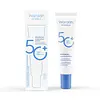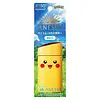What's inside
What's inside
 Key Ingredients
Key Ingredients

 Benefits
Benefits

 Concerns
Concerns

No concerns
 Ingredients Side-by-side
Ingredients Side-by-side

Water
Skin ConditioningZinc Oxide
Cosmetic ColorantC12-15 Alkyl Benzoate
AntimicrobialPropanediol
SolventMaleated Soybean Oil Glyceryl/Octyldodecanol Esters
Trisiloxane
Skin ConditioningBiosaccharide Gum-1
HumectantDibutyl Adipate
EmollientHydroxyethyl Acrylate/Sodium Acryloyldimethyl Taurate Copolymer
Emulsion StabilisingBisabolol
MaskingGlycerin
HumectantAllantoin
Skin ConditioningAvena Sativa Kernel Flour
AbrasiveCaprylhydroxamic Acid
Phenoxyethanol
PreservativeArtemisia Capillaris Flower Extract
Skin ConditioningHouttuynia Cordata Extract
Skin ConditioningHaberlea Rhodopensis Leaf Extract
Skin ConditioningCamellia Sinensis Leaf Extract
AntimicrobialPolymethylsilsesquioxane
1,2-Hexanediol
Skin ConditioningArachidyl Alcohol
EmollientButylene Glycol
HumectantTriethoxycaprylylsilane
Polyacrylate Crosspolymer-6
Emulsion StabilisingPolyhydroxystearic Acid
EmulsifyingBehenyl Alcohol
EmollientChlorphenesin
AntimicrobialArachidyl Glucoside
EmulsifyingWater, Zinc Oxide, C12-15 Alkyl Benzoate, Propanediol, Maleated Soybean Oil Glyceryl/Octyldodecanol Esters, Trisiloxane, Biosaccharide Gum-1, Dibutyl Adipate, Hydroxyethyl Acrylate/Sodium Acryloyldimethyl Taurate Copolymer, Bisabolol, Glycerin, Allantoin, Avena Sativa Kernel Flour, Caprylhydroxamic Acid, Phenoxyethanol, Artemisia Capillaris Flower Extract, Houttuynia Cordata Extract, Haberlea Rhodopensis Leaf Extract, Camellia Sinensis Leaf Extract, Polymethylsilsesquioxane, 1,2-Hexanediol, Arachidyl Alcohol, Butylene Glycol, Triethoxycaprylylsilane, Polyacrylate Crosspolymer-6, Polyhydroxystearic Acid, Behenyl Alcohol, Chlorphenesin, Arachidyl Glucoside
Octocrylene
UV AbsorberAluminum Hydroxide
EmollientPEG-10 Dimethicone
Skin ConditioningEthylhexyl Triazone
UV AbsorberSodium Chloride
MaskingDipotassium Glycyrrhizate
HumectantMelaleuca Alternifolia Leaf Extract
PerfumingSodium Citrate
BufferingPolysilicone-15
UV FilterPEG-6
HumectantTrisodium EDTA
Talc
AbrasiveCitric Acid
BufferingIsomerized Safflower Acid
Skin ConditioningDextrin Palmitate
EmulsifyingDimethicone
EmollientCitrus Unshiu Peel Extract
MaskingPEG/PPG-14/7 Dimethyl Ether
Skin ConditioningPEG/PPG-9/2 Dimethyl Ether
Skin ConditioningSodium Metabisulfite
AntioxidantC12-15 Alkyl Benzoate
AntimicrobialParfum
MaskingZea Mays Starch
AbsorbentWater
Skin ConditioningSoluble Collagen
HumectantSynthetic Ruby
AbrasiveZinc Oxide
Cosmetic ColorantIsopropyl Myristate
EmollientBis-Ethylhexyloxyphenol Methoxyphenyl Triazine
Skin ConditioningSilica
AbrasiveLauryl Betaine
CleansingIsostearic Acid
CleansingPhenoxyethanol
PreservativeButylene Glycol
HumectantHomosalate
Skin ConditioningAlcohol Denat.
AntimicrobialEthylhexyl Salicylate
UV AbsorberPEG-9 Polydimethylsiloxyethyl Dimethicone
EmulsifyingDiethylamino Hydroxybenzoyl Hexyl Benzoate
UV FilterBHT
AntioxidantSodium Benzoate
MaskingPolyglyceryl-6 Polyricinoleate
EmulsifyingTocopherol
AntioxidantSodium Acetylated Hyaluronate
HumectantTitanium Dioxide
Cosmetic ColorantGlycerin
HumectantTriethoxysilylethyl Polydimethylsiloxyethyl Dimethicone
Skin ConditioningPotentilla Erecta Root Extract
Skin ConditioningDiisopropyl Sebacate
EmollientBis-Butyldimethicone Polyglyceryl-3
CleansingTriethoxycaprylylsilane
Stearic Acid
CleansingIsododecane
EmollientDisteardimonium Hectorite
StabilisingTrimethylsiloxysilicate
EmollientOctocrylene, Aluminum Hydroxide, PEG-10 Dimethicone, Ethylhexyl Triazone, Sodium Chloride, Dipotassium Glycyrrhizate, Melaleuca Alternifolia Leaf Extract, Sodium Citrate, Polysilicone-15, PEG-6, Trisodium EDTA, Talc, Citric Acid, Isomerized Safflower Acid, Dextrin Palmitate, Dimethicone, Citrus Unshiu Peel Extract, PEG/PPG-14/7 Dimethyl Ether, PEG/PPG-9/2 Dimethyl Ether, Sodium Metabisulfite, C12-15 Alkyl Benzoate, Parfum, Zea Mays Starch, Water, Soluble Collagen, Synthetic Ruby, Zinc Oxide, Isopropyl Myristate, Bis-Ethylhexyloxyphenol Methoxyphenyl Triazine, Silica, Lauryl Betaine, Isostearic Acid, Phenoxyethanol, Butylene Glycol, Homosalate, Alcohol Denat., Ethylhexyl Salicylate, PEG-9 Polydimethylsiloxyethyl Dimethicone, Diethylamino Hydroxybenzoyl Hexyl Benzoate, BHT, Sodium Benzoate, Polyglyceryl-6 Polyricinoleate, Tocopherol, Sodium Acetylated Hyaluronate, Titanium Dioxide, Glycerin, Triethoxysilylethyl Polydimethylsiloxyethyl Dimethicone, Potentilla Erecta Root Extract, Diisopropyl Sebacate, Bis-Butyldimethicone Polyglyceryl-3, Triethoxycaprylylsilane, Stearic Acid, Isododecane, Disteardimonium Hectorite, Trimethylsiloxysilicate
 Reviews
Reviews

Ingredients Explained
These ingredients are found in both products.
Ingredients higher up in an ingredient list are typically present in a larger amount.
Butylene Glycol (or BG) is used within cosmetic products for a few different reasons:
Overall, Butylene Glycol is a safe and well-rounded ingredient that works well with other ingredients.
Though this ingredient works well with most skin types, some people with sensitive skin may experience a reaction such as allergic rashes, closed comedones, or itchiness.
Learn more about Butylene GlycolC12-15 Alkyl Benzoate is made up of Benzoic Acid and long chain alcohols. It has a low molecular weight.
C12-15 Alkyl Benzoate is an emollient and texture enhancer. Due to its solubility, it is often used in sunscreens to help evenly distribute active ingredients.
As an emollient, C12-15 Alkyl Benzoate helps soften and hydrate your skin. Emollients create a film on your skin that traps moisture within.
This ingredient has been reported to cause eye irritation.
Learn more about C12-15 Alkyl BenzoateGlycerin is already naturally found in your skin. It helps moisturize and protect your skin.
A study from 2016 found glycerin to be more effective as a humectant than AHAs and hyaluronic acid.
As a humectant, it helps the skin stay hydrated by pulling moisture to your skin. The low molecular weight of glycerin allows it to pull moisture into the deeper layers of your skin.
Hydrated skin improves your skin barrier; Your skin barrier helps protect against irritants and bacteria.
Glycerin has also been found to have antimicrobial and antiviral properties. Due to these properties, glycerin is often used in wound and burn treatments.
In cosmetics, glycerin is usually derived from plants such as soybean or palm. However, it can also be sourced from animals, such as tallow or animal fat.
This ingredient is organic, colorless, odorless, and non-toxic.
Glycerin is the name for this ingredient in American English. British English uses Glycerol/Glycerine.
Learn more about GlycerinPhenoxyethanol is a preservative that has germicide, antimicrobial, and aromatic properties. Studies show that phenoxyethanol can prevent microbial growth. By itself, it has a scent that is similar to that of a rose.
It's often used in formulations along with Caprylyl Glycol to preserve the shelf life of products.
Triethoxycaprylylsilane is a silicone used to bind and stabilize ingredients.
As an emulsifier, it helps prevent ingredients from separating. This can help elongate the shelf life of products.
Triethoxycaprylylsilane is often used to coat mineral sunscreens ingredients to help give a better feel. It also helps reduce oxidative stress in sunscreens.
Learn more about TriethoxycaprylylsilaneWater. It's the most common cosmetic ingredient of all. You'll usually see it at the top of ingredient lists, meaning that it makes up the largest part of the product.
So why is it so popular? Water most often acts as a solvent - this means that it helps dissolve other ingredients into the formulation.
You'll also recognize water as that liquid we all need to stay alive. If you see this, drink a glass of water. Stay hydrated!
Learn more about WaterZinc Oxide is a mineral broad-spectrum UV filter; it is the broadest UVA and UVB reflector approved by the FDA. It also has skin protectant and skin soothing properties.
Zinc oxide is one of the most effective broad-spectrum UV filters. It protects against UVB, UVAII, and UVAI. In comparison to its counterpart titanium dioxide, zinc oxide provides uniform and extended UVA protection.
Another great benefit? This ingredient is highly photostable so it won't degrade easily under sunlight.
A common myth is that mineral UV filters are widely believed to primarily reflect UV light.
However, modern research shows titanium dioxide absorbs UV radiation like chemical filters (~95% absorption & 5% reflection).
Zinc oxide has great skin soothing properties so you'll likely find this in sunscreens formulated for sensitive skin or babies/children. It is unlikely to cause "eye sting" like other sunscreen ingredients.
Regulatory agencies consider zinc oxide to be non-toxic and safe. It has also been shown to not penetrate the skin.
Unfortunately, this ingredient does leave a visible white cast. This is why mineral sunscreens are often less cosmetically elegant than chemical or hybrid ones.
In cosmetics, zinc oxide can be found in both non-nano and nano-sized forms. The nano version is used to reduce white cast and improve the texture of sunscreen formulas.
There are ongoing concerns surrounding nano-zinc oxide's impact on marine ecosystems and whether it can be absorbed into skin.
Regarding marine ecosystems and coral reefs, there is no conclusive evidence that any form of zinc oxide (or any other sunscreen ingredients) will cause harm. The science is still developing but many consumers are keeping a close eye on this issue.
Please note, many destinations have reef-safety sunscreen rules. For instance, the U.S. Virgin Islands advises all visitors to use non-nano mineral sunscreens.
There has also been some stir about whether micronized or nano zinc oxide has potential photoxicity and absorption through the skin/lungs.
An in-vitro (done in a test tube or petri dish) study demonstrated micronized zinc oxide to have potential phototoxicity. There's no need to fret; the EU Commission's Scientific Committee on Consumer Safety has stated, "The relevance of these findings needs to be clarified by appropriate investigations in vivo." Or in other words, further studies done on living organisms are needed to prove this.
Current research shows zinc oxide nanoparticles do not penetrate intact or sunburned skin. They either remain on the surface or in the outermost layer of dead skin (stratum corneum).
Zinc oxide is one of only two classified mineral UV filters with titanium dioxide being the other one.
Fun fact: Zinc has been used throughout history as an ingredient in paint and medicine. An Indian text from 500BC is believed to list zinc oxide as a salve for open wound. The Ancient Greek physician Dioscorides has also mentioned the use of zinc as an ointment in 1AD.
Learn more about Zinc Oxide